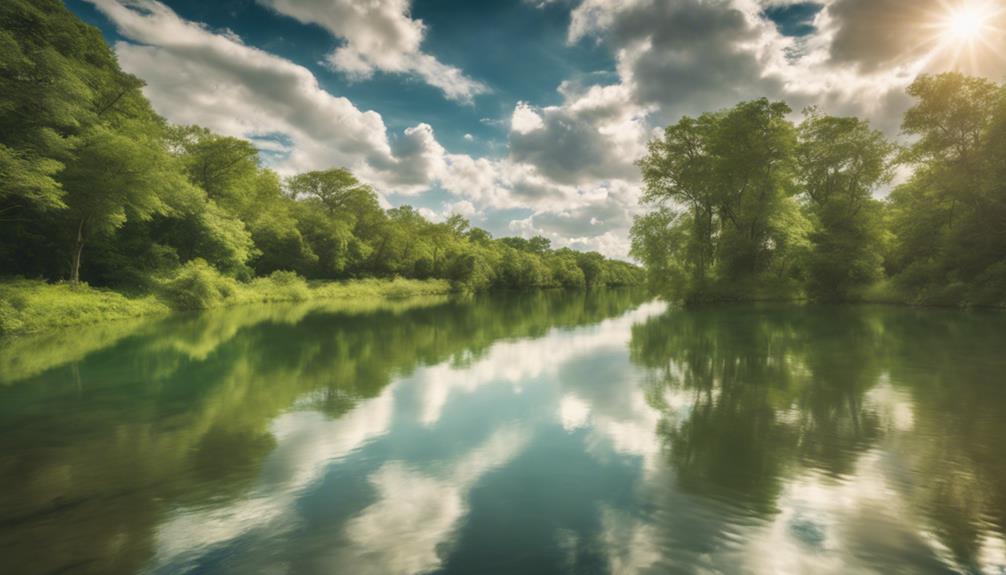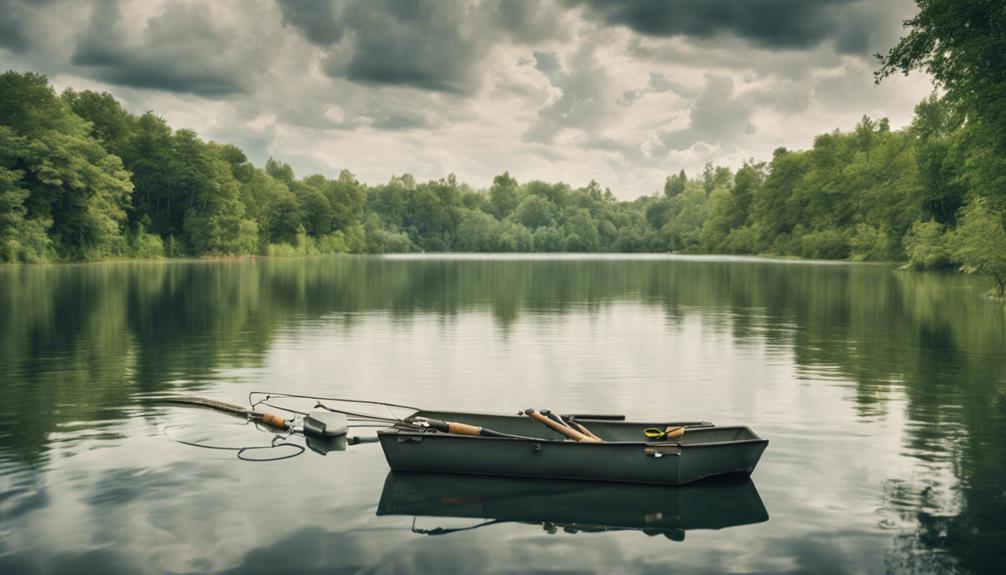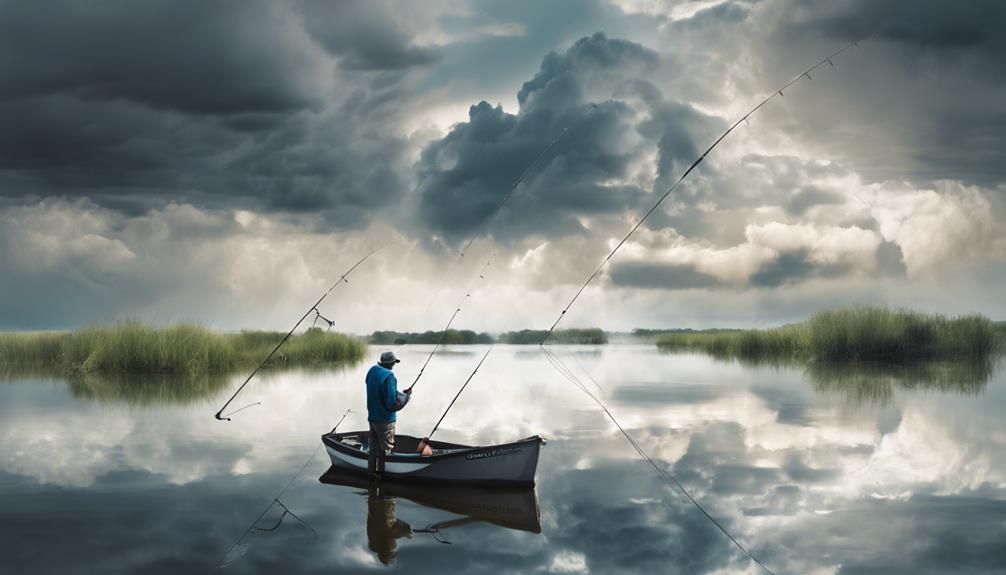To have fruitful fly fishing, aim for overcast days with light rain or partly cloudy skies. Fish tend to be more active during these conditions. Adjust your tackle selection based on the season: go for heavier weights in winter and lighter ones in summer. Wind plays a crucial role – tailwinds can help casting accuracy. Keep an eye on barometric pressure changes; they affect fish activity levels. Cloud cover can influence fish behavior, with overcast days being ideal. Experiment with different fly patterns and techniques for success. Mastering weather patterns is the first step to reeling in a great catch.
Importance of Weather Patterns
Understanding weather patterns is crucial for successful fly fishing as it directly impacts fish behavior and feeding habits. Factors such as solar activity and humidity levels play a significant role in determining your fishing success.
Solar activity, including the intensity of sunlight and its duration, influences the water temperature and subsequently affects the fish's activity levels. During periods of high solar activity, fish tend to move to deeper, cooler waters, making them less active and harder to catch. On the other hand, when solar activity is low, fish may become more active and move to shallower areas, increasing your chances of a successful fishing trip.
Humidity levels also play a crucial role in determining the optimal conditions for fishing. High humidity levels can lead to overcast skies and potentially rainy weather, which might affect fish behavior. In contrast, lower humidity levels often coincide with clear skies, making it easier to spot fish and anticipate their movements. Optimal fishing conditions are usually associated with moderate humidity levels that provide a balance between clear visibility and favorable fish activity.
Temperature's Impact on Fishing
Weather patterns significantly influence fish behavior and feeding habits, and one key aspect to consider is the impact of temperature on fishing success. Water temperature plays a crucial role in determining where fish will be located and how actively they'll feed. Different fish species have preferred temperature ranges, so understanding the water temperature can help you target the right areas. For example, trout are often more active in cooler waters, while bass may be more responsive in warmer temperatures.
In the context of fly fishing, knowing how temperature affects fish behavior can guide your approach. During the warmer months, fish may seek cooler, deeper waters to escape the heat, making early morning or late evening (sunset) fishing more productive. As the day warms up, fish might move to shallower areas or seek out shaded spots, altering your fishing strategy accordingly. Additionally, understanding temperature variations throughout the day can help you anticipate when fish will be most active.
Wind Conditions and Fly Fishing
When fly fishing, wind conditions play a crucial role in determining your success on the water. The direction of the wind can significantly impact your casting accuracy. A tailwind can help increase the distance of your cast, while a headwind may require you to adjust your casting technique to maintain accuracy. Crosswinds can make casting more challenging, so be mindful of your positioning relative to the wind direction to improve your chances of a successful cast.
In terms of fly selection, understanding how wind speed affects the behavior of different flies is essential. In windy conditions, it's beneficial to choose heavier flies that can cut through the wind more effectively. Additionally, adjusting the weight of your line or using a more aerodynamic fly pattern can help counteract the effects of strong winds. Experimenting with different fly options and adjusting your setup based on the wind speed can lead to more successful fishing outings.
Role of Precipitation in Fishing
During fishing trips, the presence of precipitation can significantly impact the behavior of fish and the overall success of your angling endeavors. Rainfall intensity plays a crucial role in determining fishing success. Light rain can often stimulate fish to become more active, feeding closer to the water's surface. However, heavy rainfall may lead to murky waters, making it harder for fish to see your bait and resulting in decreased catch rates. Therefore, adjusting your fishing techniques based on the intensity of the rain can be beneficial.
When it comes to snowfall, its impact on fishing can vary. In colder climates, snowmelt can raise water temperatures slightly, prompting fish to become more active. However, heavy snowfall can cover feeding areas, making it challenging to locate fish. Anglers can adapt to snowfall by focusing on deeper waters where fish might seek refuge from the cold or by using brightly colored baits to increase visibility in the snow-covered surroundings.
Understanding how different precipitation patterns affect fish behavior can help you strategize and optimize your fishing trips. By being mindful of rainfall intensity and snowfall impact, you can enhance your chances of a successful angling experience. Adjusting your techniques accordingly to make the most of varying weather conditions is key to maximizing your fishing success.
Understanding Barometric Pressure
Barometric pressure, a key atmospheric indicator affecting fish behavior, plays a crucial role in determining fishing success. Understanding how barometric pressure affects fish can significantly improve your chances of a successful fly fishing outing. When the barometric pressure is high, fish tend to be more lethargic and less likely to actively feed. On the other hand, low barometric pressure can stimulate fish activity, making them more likely to feed and increasing your chances of a successful catch.
To leverage this knowledge, it's essential to stay updated on weather forecasting techniques that can help you anticipate changes in barometric pressure. By monitoring weather reports and understanding how different weather systems influence barometric pressure, you can plan your fishing trips more effectively. For instance, approaching low-pressure systems often bring overcast skies and precipitation, which can lead to increased fish activity. Conversely, high-pressure systems typically result in clear skies and stable conditions, which may require adjusting your fishing strategy to entice fish to bite.
Cloud Cover and Fly Fishing Success
Monitoring cloud cover is essential for maximizing your fly fishing success, as it directly influences fish behavior and feeding patterns. Cloud cover can significantly impact your day out on the water, so understanding how it affects fish and adjusting your fishing techniques accordingly is crucial.
Here are three key points to consider when fishing in varying cloud cover conditions:
- Bright Sunny Days: On clear, sunny days with minimal cloud cover, fish tend to seek shelter in deeper waters or under vegetation to avoid the bright light. During these conditions, try using smaller, more natural-looking flies and focus on casting near structures where fish might be hiding. Additionally, consider fishing during early morning or late evening when the sun is less intense.
- Partly Cloudy Days: Partly cloudy days provide a good balance for fly fishing. Fish are more likely to be active and feeding in these conditions. Experiment with a variety of fly patterns and techniques to see what the fish respond to best. Look for feeding fish in shallower waters or near the surface where they're more visible.
- Overcast Days: Cloudy, overcast days are ideal for fly fishing as they diffuse light and make fish less wary. During these conditions, fish are more likely to venture out and feed actively throughout the day. Use larger, more visible flies and explore different water depths to increase your chances of a successful catch.
Seasonal Considerations for Anglers

Considering the seasonal variations is essential for anglers to adapt their fishing strategies effectively and maximize their chances of success on the water. Each season brings unique challenges and opportunities that can significantly impact your fishing experience.
During the spring, as rivers swell with melting snow and rainwater, the increased flow can make fishing more challenging. Anglers need to adjust their tackle selection to heavier weights to effectively target fish in these conditions. Additionally, understanding how river currents change during this season is crucial. Fish tend to seek refuge in calmer pockets of water, so identifying these areas can improve your chances of a successful catch.
Summer presents a different set of circumstances. Warmer water temperatures can lead fish to deeper, cooler sections of the river. Lighter tackle may be more appropriate during this time to entice fish in these deeper areas. Anglers should also pay close attention to how river currents shift in the summer months, as fish may move to different parts of the river to find ideal conditions.
In autumn, as temperatures cool and fish become more active, anglers may find success with a variety of tackle options. River currents can also be more predictable during this season, allowing anglers to target specific areas where fish are likely to gather.
Monitoring Weather for Fishing Success
To enhance your fishing success, understanding how weather conditions impact fish behavior is crucial. Being able to monitor the weather effectively can significantly improve your chances of a successful fishing trip. Here are some key points to consider:
- Weather Forecasting Techniques: Utilize modern weather forecasting techniques to stay ahead of the game. Keep an eye on weather apps, websites, or even specialized fishing weather services that provide detailed information on temperature changes, wind patterns, barometric pressure, and precipitation. Understanding how these factors influence fish activity can give you a competitive edge.
- Ideal Fishing Conditions: Look for specific weather conditions that are conducive to successful fishing. Fish are more likely to be active during overcast days or when there's a light drizzle. Sudden changes in barometric pressure can also trigger feeding frenzies. Additionally, pay attention to wind direction and speed as they can affect the movement of baitfish and ultimately attract larger predatory fish.
- Observation and Adaptation: Don't just rely on forecasts; be observant while on the water. Notice any changes in the weather patterns or fish behavior. Adapt your fishing techniques accordingly. Sometimes unexpected weather shifts can lead to unexpected opportunities for a great catch. Stay flexible and willing to adjust your strategy as needed.
Frequently Asked Questions
Can Fish Still Be Caught During Extreme Weather Conditions?
If you're wondering whether fish can still be caught during extreme weather conditions, the answer is yes, but with some adjustments.
Stormy days can provide excellent fishing opportunities as fish tend to be more active due to the changing atmospheric pressure.
In contrast, extreme heat can make fishing more challenging as fish may seek deeper, cooler waters.
Adapting your techniques and being patient can help you reel in a catch even in adverse weather conditions.
How Does Moon Phase Affect Fly Fishing Success?
During different moon phases, fish behavior can vary, impacting fly fishing success. The moon's position influences feeding patterns and activity levels of fish, affecting their willingness to bite.
When the moon is full or new, fish may be more active, making these times potentially more fruitful for fly fishing. Understanding how moon phase affects fish behavior can help you plan your fishing trips strategically for better chances of success.
Are There Specific Weather Patterns That Attract More Fish?
When it comes to attracting fish, specific weather patterns play a crucial role. Temperature fluctuations can trigger feeding behaviors in fish, while changes in barometric pressure can affect their activity levels.
Additionally, wind speed and cloud cover can impact where fish congregate and how they respond to bait. By understanding these weather patterns and their influence on fish behavior, you can strategically plan your fly fishing trips for better success.
Does the Time of Day Impact Fly Fishing Outcomes?
In fly fishing, the time of day significantly impacts your outcomes. Morning versus afternoon can make a big difference in your success. Fish tend to be more active in the morning when the water is cooler, and the light is softer.
However, in the afternoon, warmer temperatures might lead to more insect activity, attracting fish to the surface. Weather changes throughout the day can also influence fish behavior, affecting your chances of a successful catch.
What Role Does Water Clarity Play in Fly Fishing Productivity?
Water clarity significantly impacts your fly fishing outcomes. Clearer water allows fish to see your fly more easily, increasing the chances of a successful catch.
Temperature plays a crucial role too; certain fish species prefer specific water temperatures, affecting their activity levels. Understanding how visibility and temperature intertwine can help you strategize your fishing approach for better results.
Pay attention to these factors to enhance your fly fishing productivity.
Conclusion
To maximize your success in fly fishing, it's crucial to pay attention to the optimal weather patterns. Factors such as temperature, wind conditions, precipitation, barometric pressure, and cloud cover all play a significant role in determining the productivity of your fishing trip.
By understanding how these elements influence fish behavior, you can strategically plan your outings and increase your chances of landing that prized catch.
Stay informed, monitor the weather, and get ready for a fruitful fishing experience.



